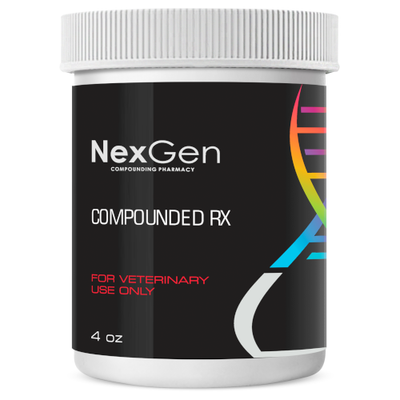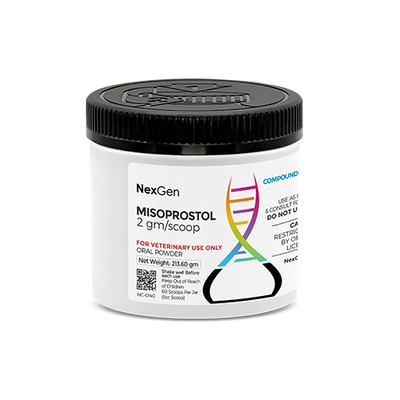
Pergolide 1 mg/scoop, Oral Powder, 100 Scoops (1.25cc Scoop)
Login for pricing
- Brand
- Mixlab
- SKU:
- NC-0056
- Product Type:
- Powder
- Size:
- 4oz
- Administration:
- Oral
- Scoops Per Container:
- 100
- Scoop Size:
- 1.25cc
Equine Cushing’s disease is a complex progressive disease of the pituitary gland of middle aged to older horses. This condition occurs when the production of dopamine (a neurotransmitter that normally controls the function of a specific portion of the pituitary gland) decreases. The deficiency in dopamine results in an increase in the size of the pituitary gland, subsequently resulting in an increase in the production of adrenocorticotropic hormone (ACTH) and other proteins from cells of the affected pituitary. Following this, elevated levels of ACTH cause overproduction of the hormone cortisol from the adrenal gland.
Signs associated with pituitary disease (Equine Cushing’s disease) in horses are generally slow onset in nature, and may include:
- Development of a long, curly coat
- Increased water consumption
- Increased urination
- Excessive sweating
- Lactation1
Horses suffering from Equine Cushing’s disease are also prone to chronic infections such as sinusitis, dental disease, and sole abscesses. These conditions are caused by immunosuppression that is a result of prolonged exposure to elevated levels of cortisol. Horses with Cushing’s disease may experience recurrent episodes of laminitis (founder) with no other known predisposing causes. Mares with Cushing’s disease often have reproductive problems such as complete failure to cycle, irregular estrous cycles, estrus suppression, and reduced fertility. “The reproductive problems may be due to suppression of follicle stimulating hormone (FSH) and luteinizing hormone (LH) production due to the elevated levels of cortisol and/or androgens secreted by the hyperstimulated adrenal glands. In addition, enlargement of the affected area of the pituitary may lead to compressive destruction of the pituitary cells that produce FSH and LH.”1 Insufficient FSH and LH would tend to lead to a decrease in follicular development and failure of ovulation in the mare.
The aforementioned hair coat changes usually develop years after the beginning of pituitary dysfunction. Subtle hair coat changes, such as development of patchy areas of long hairs and a tendency for the winter hair coat to come in earlier and shed out later than normal, may precede more profound changes by many years.
Diagnosis
Diagnosis of Cushing’s disease is usually based on clinical signs and blood tests. Affected horses may have elevated levels of glucose, insulin, cortisol and ACTH in their blood. Additional diagnostic tests include evaluation of cortisol levels in blood samples collected 8 to 10 hours apart or measurement of cortisol levels before and after administration of dexamethasone (the dexamethasone suppression test) or other hormones.
The dexamethasone suppression test is considered to be the favored method for diagnosis of Cushing’s disease in horses. Administration of dexamethasone to normal horses causes marked suppression of blood cortisol, whereas horses with Cushing’s disease have little to no change in cortisol levels in response to dexamethasone. “Evaluation of cortisol rhythm is a relatively common screening test for the presence of Cushing’s disease and is often performed as an alternative to the dexamethasone suppression test in horses with a history of laminitis. However, the cortisol rhythm test may yield false positive or false negative results, and one needs to be cautious basing a diagnosis on this test alone.”1
Treatment With Pergolide
Pergolide is a potent agonist at dopamine receptors (D1 and D2) and is 10-1000 times more potent than bromocriptine. It is thought that PPID in horses is a dopaminergic degenerative disease and pergolide (or dopamine) can reduce expression of proopiomelanocortin (POMC) peptides from the pars intermedia.
Pharmacokinetic studies of pergolide in horses are limited and provide varying information. In a study involving six horses, pergolide was rapidly absorbed following oral administration (0.01 mg/kg) with plasma concentrations reaching maximum levels within 1 hour of dosing. Maximum plasma levels ranged from 1.07-3.38 nanograms/mL. Pergolide appears to be rapidly and widely distributed. Elimination half-life averaged 27 hours, but there was high interpatient variation.3
In a study evaluating 6 horses, 2 mg (~0.004 mg/kg) of pergolide was given each day over a period of six months. Pharmacokinetic parameters were measured after the last dose each day during the six month period. Maximum plasma levels were reached on average within 1 hour of dosing at levels ranging from 0-1.38 ng/mL. Average elimination half-life was determined to be 19.7 hours.4
In a study evaluating 8 healthy, young horses, pergolide 0.02 mg/kg IV was given. The mean maximum concentration was found to be 15.62 ng/mL, with a mean terminal elimination half-life of 5.14 hours.5
Where to buy Pergolide
Pergolide is available in the U.S. through several pharmaceutical manufacturers and through veterinary custom compounding companies.
FOR RX ONLY: A valid prescription from a licensed veterinarian is required for dispensing this medication.
1McCue, Patrick. (2003). Equine Cushing's disease. The Veterinary clinics of North America. Equine practice. 18. 533-43, viii. 10.1016/S0749-0739(02)00038-X.
3Gehring R, et al. Single-Dose Oral Pharmacokinetics of Pergolide Mesylate in Healthy Adult Mares. Vet Therapeutics. 2010;11(1):E1-E8.
4McFarlane D, et al. Pharmacokinetic and pharmacodynamic properties of pergolide mesylate following long-term administration to horses with pituitary pars intermedia dysfunction. J Vet Pharmacol Ther. 2017;40(2):158-164.
5Rendle DI, et al. Pharmacokinetics of pergolide after intravenous administration to horses. Am J Vet Res. 2015;76(2):155-160.
6avma.org.
















